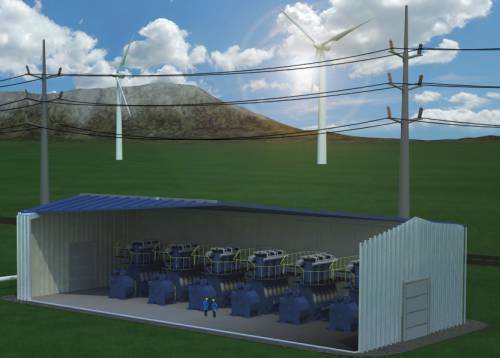We don’t expect the wind and solar naysayers to give up any time soon, but new utility-scale energy storage solutions are beginning to come on line, and they will put to rest this whole notion that intermittent energy sources (namely, wind and solar) can’t provide a significant proportion of reliable power to the national grid.
The latest development comes from a company called SustainX, Inc. The technology is called an isothermal compressed air energy storage system, and since we’ve been following its progress for the past several years we’re happy to tell you that SustainX has completed construction of its first utility scale system. It was hooked up to the grid earlier this month and it’s now in the process of revving up to speed.
An Isothermal Compressed Air Energy Storage System
We first took note of SustainX back in 2009, when it spun out of Dartmouth College. The goal was to store four megawatt-hours worth of energy in transportable 40-foot long containers, while achieving a 70% reduction in the amount of energy needed for conventional compressed air energy storage (CAES) systems.
Last year, the company took a big leap forward by entering a technology licensing agreement with the University of Minnesota.

Isothermal refers to storage of compressed air at a constant temperature, which is a key element in the improved energy efficiency of the system.
The new SustainX CAES system is located in New Hampshire, at the SustainX headquarters. As SustainX describes it, the new system represents a next-generation improvement over earlier CAES systems dating back to the 1970′s which typically are located underground and run on fossil fuel.
The SustainX system was designed to run on grid-supplied electricity, so depending on the local grid mix it can potentially run exclusively on emission free sources including wind and solar. That also means that it is not dependent on caves or other geological quirks for site selection.
Some patented, cutting edge tweaks by SustainX make all the difference, but other than that, the entire system consists of practically nothing but steel, water, and air. Here’s how it works:
A mechanical drivetrain utilises an electric machine and a crankshaft…This efficient mechanical link powers a two-stage, mixed-phase (water-in-air) heat-transfer process within pneumatic cylinders. During piston strokes, water is sprayed into the air-filled chamber of each cylinder, allowing heat to be transferred from water to air during expansion or from air to water during compression. The same ICAES power unit provides both isothermal compression and expansion, eliminating the cost of separate compressor and expander subsystems.
We Built This CAES!
If the new facility proves successful we taxpayers can all do a group hug because SustainX received a $5.4 million award from the Department of Energy to help accelerate the project, as part of the Obama Administration’s Smart Grid initiatives.
The project, which also includes private sector investors, appears to be on track. Completion of the test phase is due by the end of this year and a final technology report is due in 2015.
CAES and other new storage technologies fit into the Smart Grid concept partly by eliminating the need to construct new peaking plants. Peaking plants, which typically run on natural gas, are designed to come on line quickly to address demand spikes, but most of the time they sit idle, which means that they are a very expensive way to provide for variations in local energy consumption to say nothing of their dependence on fossil fuel sources.
In terms of the levelized cost of energy (LCOE, not to be confused with EROI), a mechanically simple system like the SustainX solution has some clear advantages over building new peaking plants, including the potential for far lower operating, maintenance and repair costs in addition to lower fuel costs.
In the past, CAES systems were primarily sited to take advantage of caves and other geological quirks, so the Smart Grid goal of developing more geographically flexible, above ground systems is also critical if CAES is to play a major role in the national grid.
The Future Of CAES
Coincidentally, just last month CleanTechnica covered a new report by the consulting firm Navigant, which predicted a burst of growth in the CAES market as new technologies climb out of the R&D stage including scalable, modular systems.
In that regard, we’re following a company called LightSail, which has developed an energy efficient, mist-cooled system that enables above-ground storage. Last we heard, LightSail had secured $5.5 million in private funding for its CAES project from A-list investors including Bill Gates and PayPal co-founder Peter Thiel.
The underground storage approach is also still worthy of development in certain regions, as evidenced by Pacific Northwest National Laboratory, which has been researching the potential for storing compressed air in porous rocks in the Northwest.
This article was originally published on CleanTechnica. Reproduced with permission
Read more at http://cleantechnica.com/2013/09/23/sustainx-completes-new-compressed-air-energy-storage-system/#IAXDPjdXMBpghCjw.99








